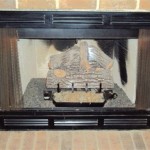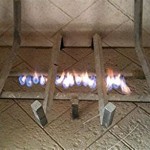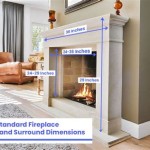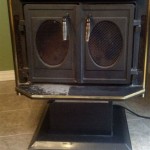How To Install Stone Fireplace Veneers: A Comprehensive Guide
Installing stone fireplace veneers is a popular home improvement project that can dramatically enhance the aesthetic appeal of a living space. It provides the appearance of a traditional masonry fireplace without the expense or structural requirements of a full stone structure. This guide outlines the necessary steps for successfully installing stone fireplace veneers, ensuring a durable and visually pleasing result.
Before commencing the installation, it is crucial to thoroughly assess the existing fireplace structure. The surface must be clean, structurally sound, and capable of supporting the weight of the stone veneer. Materials required include stone veneer panels, mortar, mortar mixing tools, a notched trowel, a level, a measuring tape, a diamond blade saw or angle grinder with a masonry blade, safety glasses, work gloves, and potentially metal lath and fasteners depending on the substrate. Proper planning and preparation are essential for a successful outcome.
Surface Preparation and Substrate Considerations
The preparation of the surface onto which the stone veneer will be applied is paramount for its long-term adhesion and stability. The existing fireplace surface needs to be thoroughly cleaned to remove any dirt, dust, grease, or loose paint. A wire brush can be useful for removing stubborn debris. If the existing surface is painted or coated, it is generally recommended to remove the coating to ensure proper mortar adhesion. A pressure washer can be utilized for thorough cleaning, but it's vital to allow the surface to completely dry before proceeding.
The substrate, the underlying material of the fireplace, dictates the requirement for additional reinforcement. If the substrate is brick or concrete, it generally provides a suitable surface for direct application of the stone veneer, assuming the surface is structurally sound. However, if the substrate is wood, drywall, or other non-masonry material, the installation of metal lath is highly recommended. Metal lath provides a mechanical key for the mortar, significantly improving its adhesion to the non-masonry substrate.
To install metal lath, it should be cut to size to fit the surface of the fireplace. It is then attached to the underlying structure using appropriate fasteners, such as screws or nails designed for the specific substrate. Overlap the edges of the metal lath by at least one inch to create a continuous, reinforced surface. Once the metal lath is securely attached, a scratch coat of mortar should be applied. This scratch coat should be approximately ½ inch thick and should be scored horizontally with a notched trowel. The scoring creates additional surface area for the stone veneer mortar to adhere to. Allow the scratch coat to cure for at least 24-48 hours before proceeding with the stone veneer installation.
Mixing and Applying the Mortar
The mortar is a critical component of the stone veneer installation. It acts as the adhesive that bonds the stone to the substrate. It is important to use a mortar specifically designed for stone veneer applications. These mortars typically have additives that enhance their adhesion, flexibility, and water resistance. Follow the manufacturer's instructions precisely when mixing the mortar.
Typically, the mortar is mixed with water to achieve a consistency similar to peanut butter. Avoid adding too much water, as this can weaken the mortar and reduce its bonding strength. Use a mortar mixer or a drill with a mixing paddle to ensure a consistent and lump-free mixture. Allow the mortar to slake, or stand, for a few minutes after mixing, and then remix it briefly before use. This process allows the additives in the mortar to fully activate.
Applying the mortar correctly is essential for a strong and durable bond. Use a notched trowel to apply a layer of mortar to the back of each stone veneer panel. The notches in the trowel create ridges in the mortar, which increase the surface area for adhesion. Ensure that the entire back of the stone veneer panel is covered with mortar, paying particular attention to the edges. Press the stone veneer panel firmly onto the prepared surface, wiggling it slightly to ensure good contact. Excess mortar that squeezes out from the edges should be removed with a small trowel or putty knife. This prevents the mortar from drying on the face of the stone veneer and creating a difficult-to-remove stain.
Cutting and Installing the Stone Veneer
The stone veneer panels will likely need to be cut to fit around openings, corners, and edges of the fireplace. A diamond blade saw or an angle grinder with a masonry blade is recommended for cutting stone veneer. Always wear safety glasses and work gloves when cutting stone veneer, as the process can generate a significant amount of dust and debris. Measure the required cuts carefully and mark them on the stone veneer panel with a pencil. When cutting, make a clean, straight cut, following the marked line. For more intricate cuts, a wet saw may be preferred to minimize dust and provide a cleaner edge.
Start installing the stone veneer from the bottom, working upwards. This allows the weight of the upper rows to be supported by the lower rows. Use a level to ensure that each row is straight and level. Stagger the joints between the stone veneer panels to create a more natural and visually appealing appearance. The spacing between the panels, known as the joint width, can be adjusted to create different aesthetic effects. A wider joint width will typically require more mortar, while a narrower joint width will create a more seamless look.
At corners, use corner stone veneer panels, if available, to create a finished edge. If corner pieces are not available, miter the edges of the stone veneer panels to create a 45-degree angle. This will create a clean and professional-looking corner. Once all the stone veneer panels have been installed, allow the mortar to cure completely according to the manufacturer's instructions. This may take several days, depending on the temperature and humidity.
After the mortar has cured, the joints between the stone veneer panels can be pointed. This involves filling the joints with mortar to create a finished look. Use a grout bag or a small trowel to apply the mortar to the joints. Overfill the joints slightly, and then use a jointing tool to compress and shape the mortar. The jointing tool will also remove any excess mortar from the face of the stone veneer. Allow the joint mortar to cure slightly, and then brush the joints with a soft brush to remove any crumbs or debris.

How To Install A Stone Veneer Fireplace Shoe Makes New

Thin Stone Veneers Make A Fireplace Update Easy Swenson Granite 100 Natural Stones

How To Install Stone Veneer On A Fireplace Step By Guide
Installing Stone Veneer On Wall With Fireplace Hearth Com Forums Home

How To Install Faux Stone Veneer Lowe S

Diy Interior Stone Fireplace Selex

Learn How To Install Stone Veneer On Walls Fireplace More Remodel

How To Install A Stone Veneer Fireplace Shoe Makes New

Refacing A Fireplace With Stone Veneer Horizon

Installing A Stone Veneer Fireplace With Evolve








